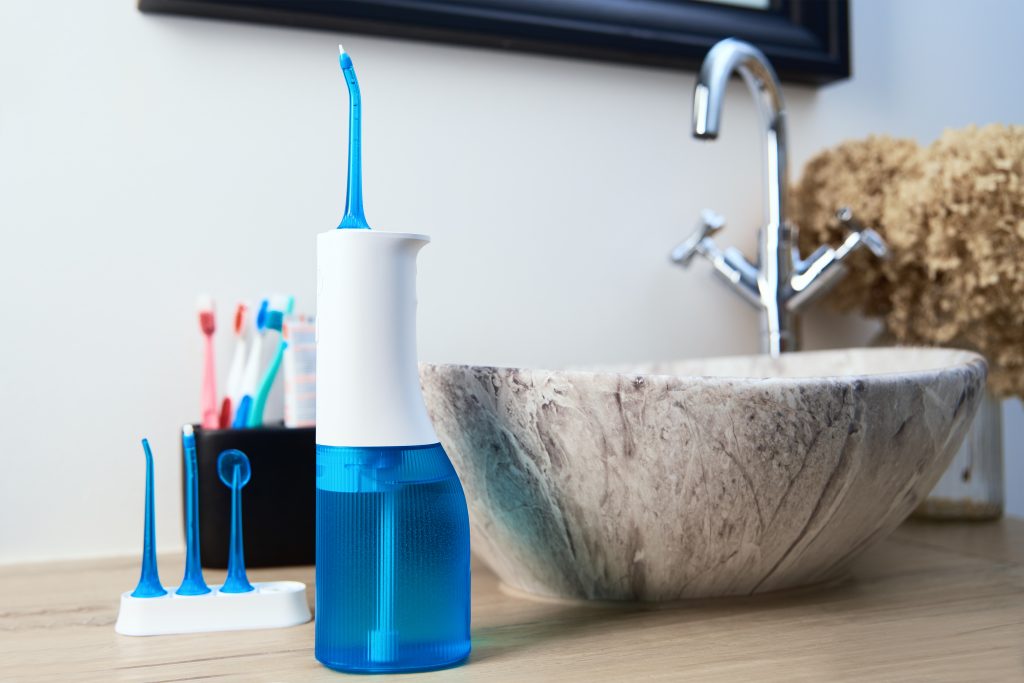It’s a given: whether or not you’re undergoing orthodontic treatment – you need to floss your teeth.
Lack of a diligent flossing routine is an easy hole to dig… and a very difficult hole to get out of! Flossing regularly is especially crucial if you wear braces; there are far more areas where food particles can get trapped, attracting the bacteria that form plaque.
We understand that traditional string flossing can be cumbersome; many patients with braces experience difficulty working the thread around their wires and brackets. An “alternative” method of flossing is gaining popularity.
The use of an “oral irrigator” allows you to floss with water. It is a wand that – using a combination of pressure and rhythm – sends a stream of water that – when aimed at your teeth – can “deep clean” between the teeth and below the gum line. This procedure is effective for everyone, and can be used as an alternative, or in addition to string flossing.
What is a Water Flosser?
A water flosser is a wand-shaped instrument that contains a reservoir that is filled with water or mouthwash.
Different heads or “tips” can be fastened to the end of the wand for different streams of water or cleaning techniques. While there is no “right or wrong” tip to use for your water flosser, we would recommend “classic jet tip” for general use and “orthodontic tip” for braces wearers.
“Waterpik” is the most common brand of water flosser available for purchase.
How to Use a Waterpik Water Flosser
Two wise rules to remember here are “lean over the sink” and “always place the attached tip in your mouth before you turn the unit on.” This will help greatly to minimize any mess as you grow accustomed to using the flosser.
The flosser’s base comes with a dial that allows you to set the pressure of the water to your liking. We recommend using the ‘lowest pressure position’ until you gain comfort using the flosser. You can then increase the pressure to your liking.
With the wand’s tip placed in your mouth, aim the water stream just above your gum line at a 90° angle. Turn the wand on when you’re ready, and – starting with the back teeth – spray the water stream at and between the teeth, following the gum line.
If you need a break while flossing, especially as you get accustomed to using the flosser, the wand has a “pause” button.
The video below gives a great visual aid of how to use the flosser:
How do I know which flosser to purchase?
Finding the right water flosser comes down to settings, tips and reservoir size. They come in both corded and cordless varieties. Battery life becomes an issue with the cordless varieties.
Water Flossing vs. Traditional String Flossing
Most dentists still consider traditional string flossing the best way to clean between your teeth. However, our practice has observed teenagers with braces find that a water flosser is much easier and less time consuming than using string floss. Patients with dental implants and bridges may also experience more comfort and ease of use in water flossing versus string floss.
You may wish to still carry a container of floss or proxabrushes for instances where it’s not possible to bring the Waterpik wand and base, such as school, work, or a day trip where you know you’ll be eating a meal.
The American Dental Association gives water flossers with the ADA Seal of Acceptance the “thumbs up” to use in combatting plaque and gum disease. While flossing with water has become the preferred way to floss for many, it is not intended to be a corner-cutting practice, much like mouthwash was never intended to be a complete substitute for brushing with toothpaste. Like any aspect of oral health care, you will need to commit to water flossing regularly!
If you feel you or a family member may benefit from orthodontic treatment, contact Koch Orthodontics today. Like us on Facebook and follow us on Instagram for an inside look at who we are, and what we do!

